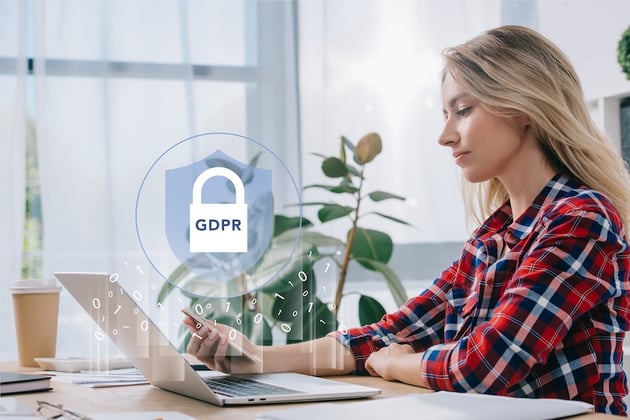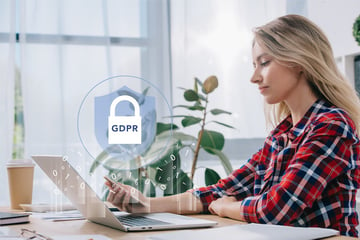GDPR isn’t a new concept anymore, but it can still be a lot of work to implement. Let’s explore the current best practices for abiding by these laws and regulations.
Best Practices for GDPR Compliance
Compliance with GDPR will take a minute to get put in place. So, take the following best practices one at a time until you’ve moved through them all.
1. Appoint a Data Protection Officer
A Data Protection Officer (DPO) is key to GDPR compliance. This individual oversees privacy policies, monitors compliance, and serves as a contact between the company and regulatory authorities.
Not every business will need this, especially if you’re a small business owner or solopreneur, however, if you’re working with a larger organization, you can expect a DPO to:
- Ensure alignment with GDPR requirements.
- Provide data protection training to staff.
- Guide the organization through data protection impact assessments.
- And serve as a contact point within the company for addressing inquiries related to data protection.
The DPO is more than a regulatory requirement. It’s actually a symbol of your organization’s commitment to privacy. And it sets the stage for a comprehensive privacy strategy that aligns with modern expectations.
2. Classify All Data
Understanding the nature of the data you handle is a fundamental step in GDPR compliance. Classifying all data helps you identify what information falls under the regulation and how it should be treated.
- Identify Personal Data: Recognize what constitutes personal data under GDPR, including names, email addresses, IP addresses, and more.
- Categorize Sensitivity: Determine the sensitivity of the data, such as financial information, health records, or other special categories.
- Apply Appropriate Security Measures: Based on classification, implement security controls to protect data according to its sensitivity.
Classifying data is an ongoing process that requires regular review and updates. It ensures that you are aware of the data you hold and that you apply the necessary protections.
3. Complete a Privacy Impact Assessment



Next, a Privacy Impact Assessment helps you evaluate the potential risks to individual privacy when processing personal data.
- Identify Risks: Assess the risks associated with data processing activities.
- Evaluate Mitigation Strategies: Determine measures to reduce or eliminate identified risks.
- Document Findings: Maintain a record of the assessment, including the risks and mitigation strategies.
Completing a PIA helps you understand the potential impact of your data processing activities and take proactive steps to safeguard privacy. It’s a valuable exercise in transparency and accountability.
4. Document, Maintain, and Enforce Privacy Policies, Procedures, and Processes
Documentation is at the heart of GDPR compliance. It’s not enough to have policies in place. You also must maintain and enforce them. To do this, you’ll need to complete the following 4 steps:
- Create Clear Policies: Develop comprehensive privacy policies that outline how personal data is collected, processed, and stored.
- Implement Procedures: Establish procedures to ensure that policies are followed, including data access controls, breach response, and more.
- Maintain Records: Keep detailed records of data processing activities, including the purpose, categories of data, and retention periods.
- Enforce Compliance: Regularly review and enforce policies, ensuring that all staff are aware of and adhere to privacy requirements.
Documenting and enforcing privacy policies demonstrates your commitment to data protection. It provides a clear roadmap for compliance and builds trust with data subjects.
5. Ensure Transparency with Third-Party Integrations
Third-party integrations are common and often necessary for running a successful website. Ensuring transparency with these integrations is vital for GDPR compliance as well.
To do this, you’ll need to immediately clarify who has access to personal data on your website and for what purpose.
Then you’ll need to evaluate the compliance offered by the third-party service. Then create clear agreements that outline responsibilities and expectations regarding data protection. Basically, you need to disclose to your site visitors when third-parties are collecting information and ensure that they comply to GDPR in how they handle that information.
6. Implement Strong Consent Mechanisms
Consent is a cornerstone of GDPR. Implementing strong consent mechanisms is the key to data processing that sticks to what the law requires.
- Provide Clear Information: Offer clear and concise information about how data will be used.
- Obtain Explicit Consent: Ensure that consent is freely given, specific, informed, and unambiguous.
- Maintain Consent Records: Keep records of when and how consent was obtained.
- Allow Easy Withdrawal: Enable individuals to easily withdraw consent at any time.
Strong consent rules empower people to control their data and reinforce your commitment to privacy.
7. Regularly Review and Update Compliance Measures
GDPR compliance is not a static goal. It requires ongoing attention and adaptation. It’s essential that you perform regular audits to assess compliance and identify areas for improvement.
You’ll also need to update policies and even change your compliance measures to fit with new regulations or changes to existing rules.
Speaking of, you’ll need to keep an eye on changes in legislation to keep your site up-to-date and in compliance at all times.
Regular review and updates ensure that your compliance measures remain effective and aligned with current regulations.
Your Most Pressing Questions About GDPR Answered
GDPR can be a complicated topic to navigate. To help you understand the regulations and ensure compliance, here are answers to some of the most common GDPR questions and our answers to them:
1. When I have a website client from a country outside the EU, do I need to think about cookie consent?
Yes, if your website is accessible to individuals within the EU, you must obtain consent for the use of cookies, regardless of where your client is based. GDPR requires clear and informed consent for the use of cookies that track personal information.
2. Does including Google Analytics or Google Fonts mean I have to tell users?
Yes, including tools like Google Analytics or Google Fonts may involve processing personal data such as IP addresses. You should inform users about this in your privacy policy and obtain consent if required under GDPR.
3. If images are served from a CDN or just from a server in the US, is that something I have to warn users about?
If the CDN or server processes personal data of EU citizens, you should inform users about this. Transparency about data processing, including where and how data is stored and transferred, is a key principle of GDPR.
4. What about MailChimp? Don’t they just take care of my GDPR responsibilities?
While MailChimp offers GDPR-compliant features, it does not absolve you of your responsibilities. You must ensure that you are using these features correctly and that your overall data processing activities comply with GDPR.
5. How does GDPR affect small businesses specifically?
GDPR applies to all businesses, regardless of size, that process personal data of EU citizens. Small businesses must comply with the same regulations, although some provisions may vary based on the volume and nature of data processing.
6. Can GDPR compliance be automated, and what tools are available?
While some aspects of GDPR compliance can be automated, such as consent management, it requires a comprehensive approach. Tools like OneTrust, TrustArc, and others can assist with automation but cannot replace a thorough understanding and implementation of GDPR principles.
7. What are the penalties for non-compliance with GDPR?
Penalties for non-compliance can be severe, ranging from warnings to fines of up to €20 million or 4% of the company’s global annual turnover, whichever is higher.
8. What constitutes personal data under GDPR?
Personal data under GDPR includes any information that can identify an individual, either directly or indirectly. This includes names, email addresses, phone numbers, IP addresses, and more.
9. How to handle data breaches under GDPR?
GDPR requires organizations to report data breaches to the relevant supervisory authority within 72 hours of becoming aware of the breach. Affected individuals must also be notified if there is a high risk to their rights.
GDPR is About More Than Checking Boxes
GDPR is not a mere regulatory obligation but a commitment to respect individual privacy rights and ensure data security. Understanding and implementing GDPR principles in your business operations is a must if you wish to foster trust, transparency, and responsibility.
It may seem daunting at first, but with the right approach and tools, you can navigate these requirements.
But remember, GDPR compliance is an ongoing process that requires regular audits, policy updates, and training. Stay informed, be proactive, and embrace GDPR as a step towards a more secure and privacy-focused online experience for all.